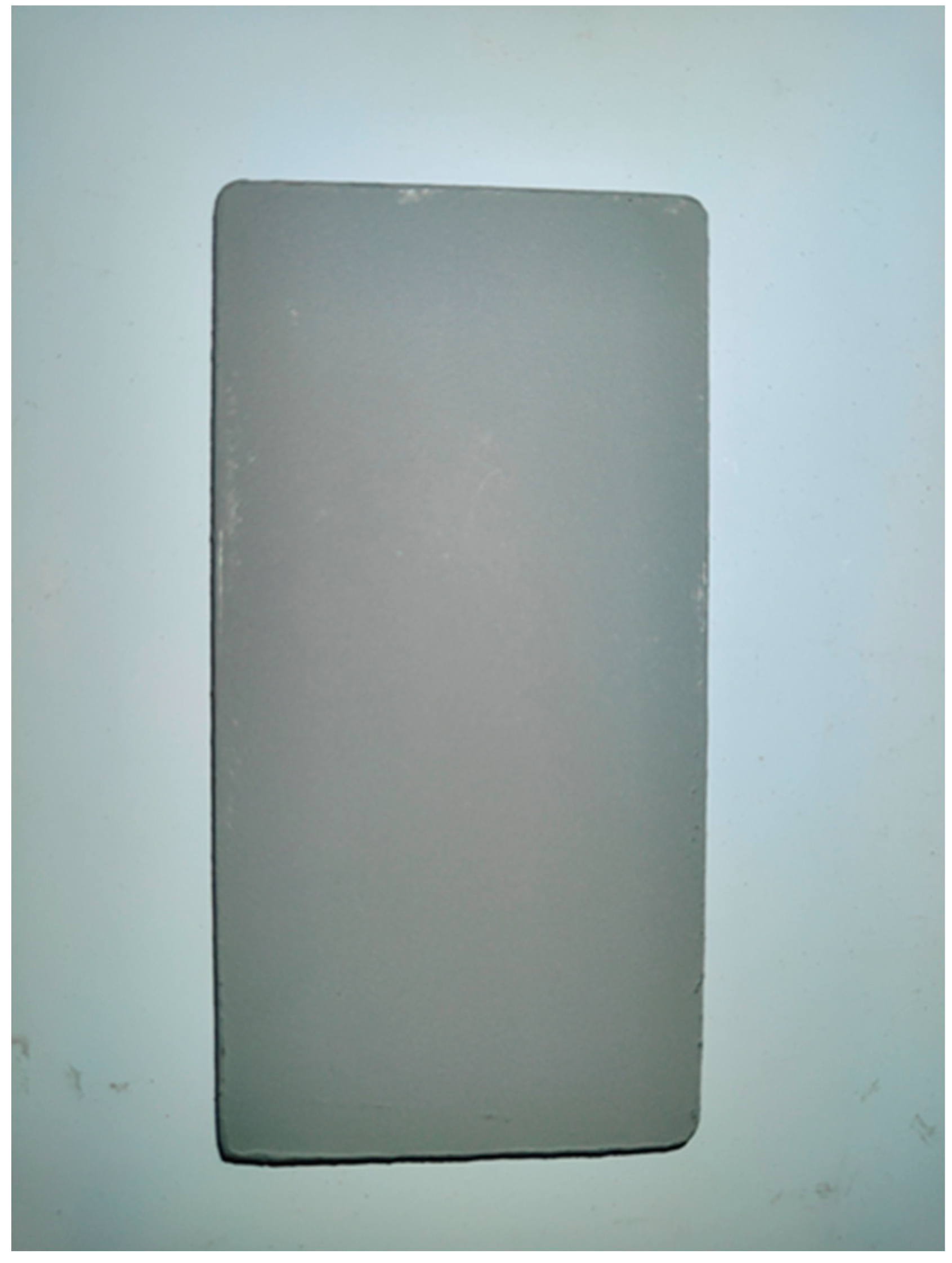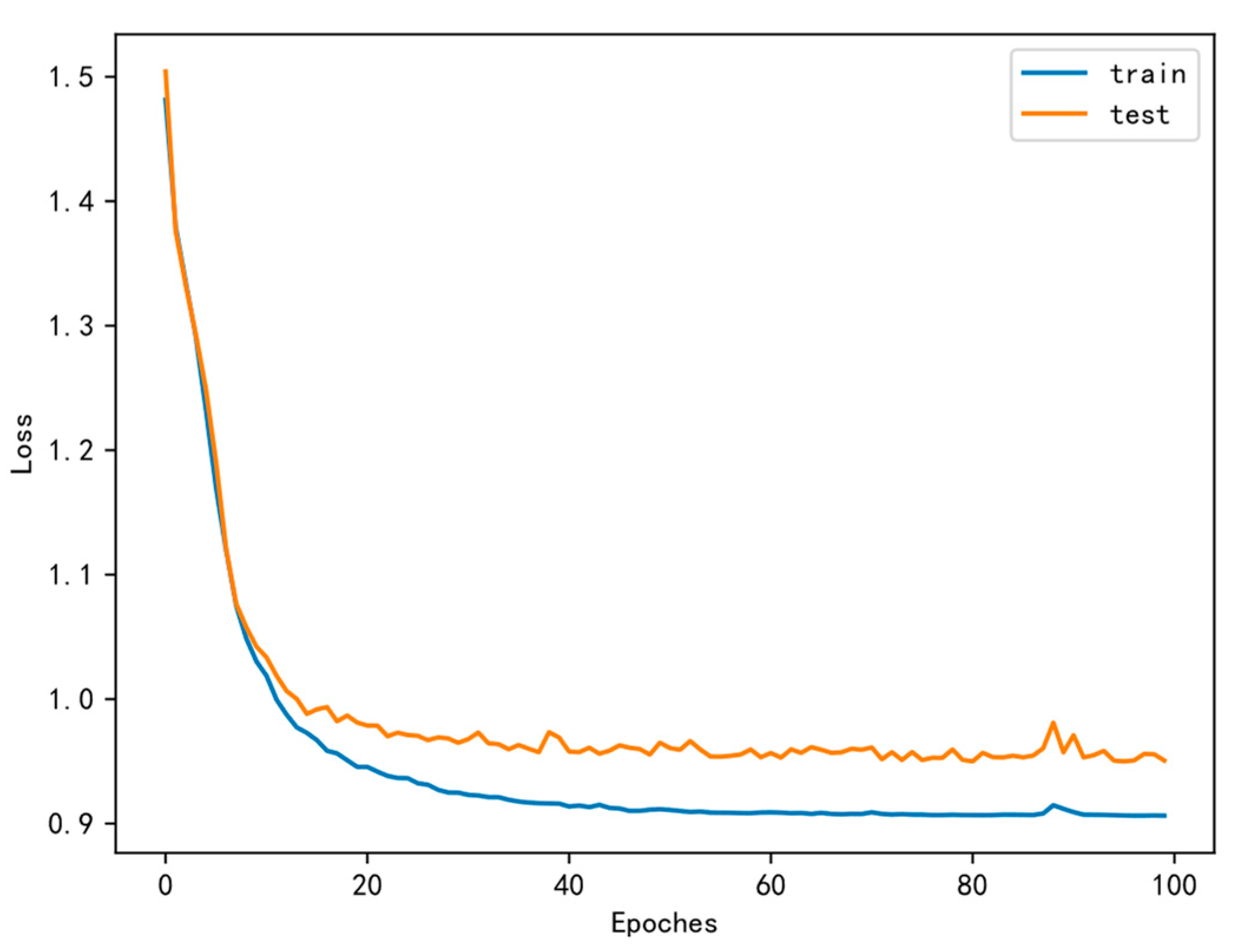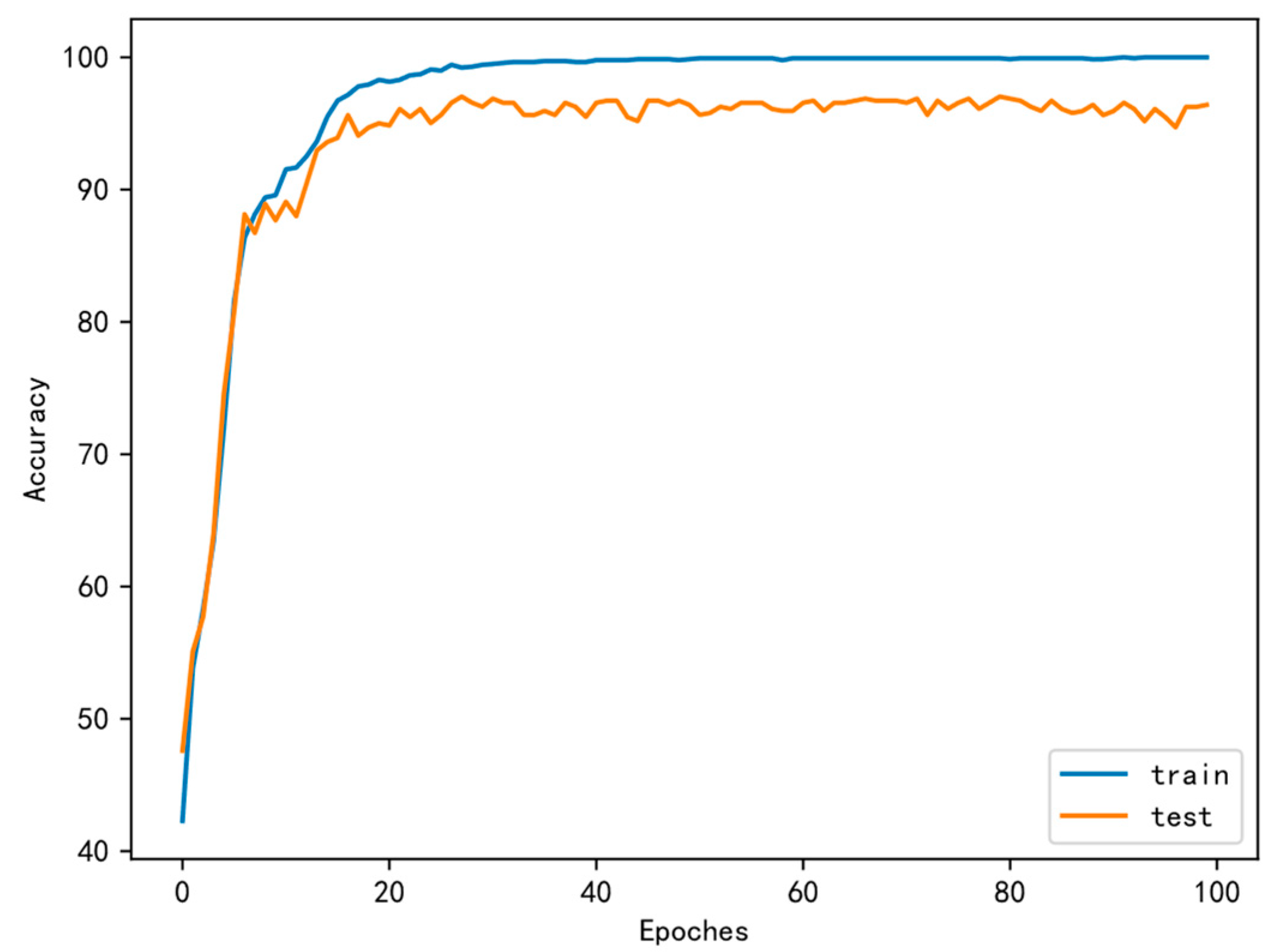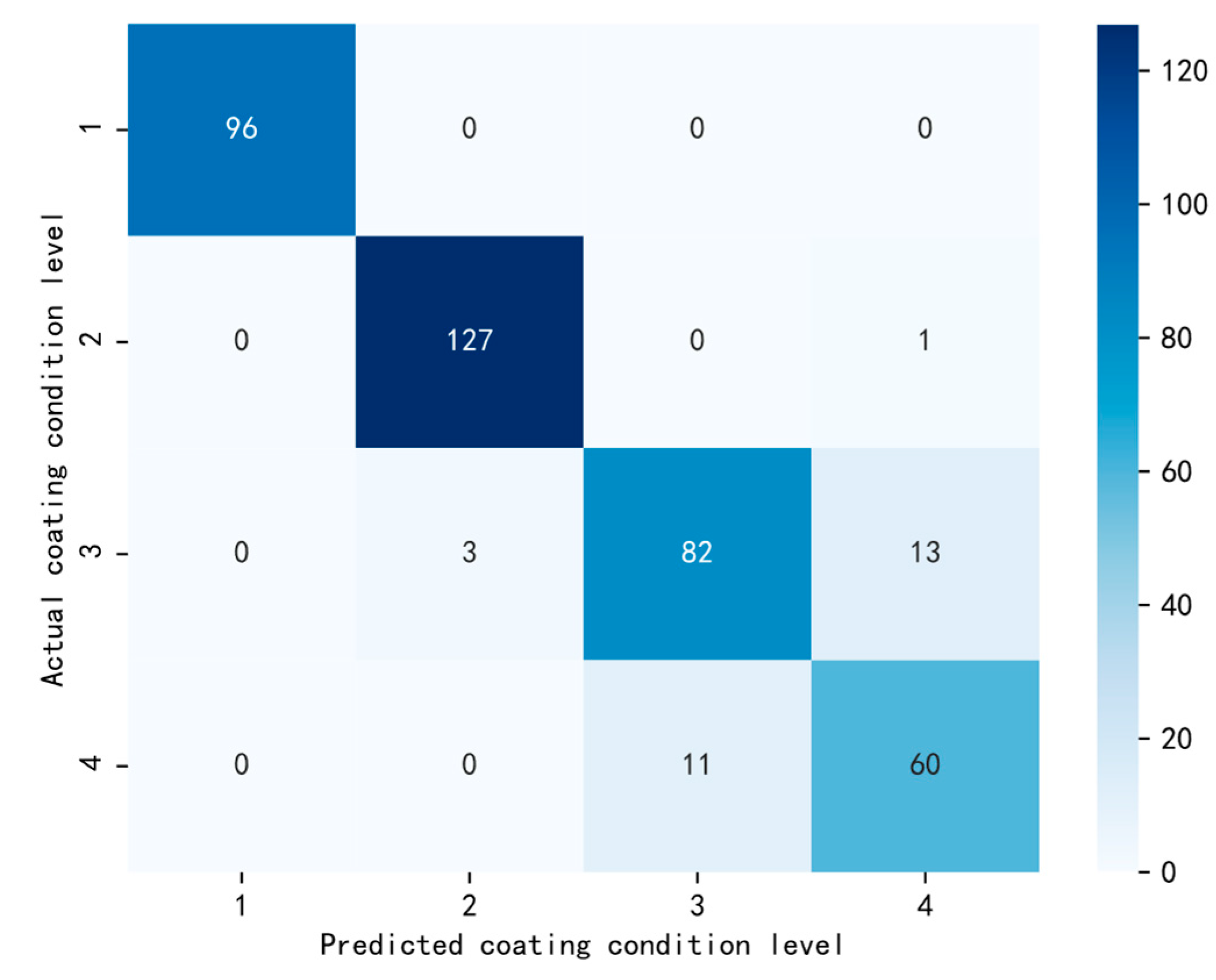Discrimination of Steel Coatings with Different Degradation Levels by Near-Infrared (NIR) Spectroscopy and Deep Learning
Abstract
:1. Introduction
2. Materials and Data Collection
2.1. Sample Preparation
2.2. Data Acquisition and Labelling
3. Methodology
3.1. Pre-Processing of NIR Data
3.2. Architecture of the Proposed CNN Based Model
3.3. Performance Evaluation
3.4. Software Tools
4. Results and Discussion
4.1. Spectral Characteristic
4.2. Preprocessing Method
4.3. CNN-Based Steel Coating Condition Assessment Model
5. Conclusions
- The characteristics of the spectrum showed a downward trend over the entire wavenumber period, and two major absorption peaks were observed around 5250 and 4400 cm−1;
- A decrease in the reflectance of the spectrum features was observed along with the coating degradation process;
- A comparison of the different preprocessing methods indicated that the SG smoothing method was the most suitable method for the proposed model to effectively improve classification performance;
- Based on the above data and pretreatment, the experimental results of the proposed model achieved an overall prediction accuracy of 95.8% and very minimal error measures.
Author Contributions
Funding
Institutional Review Board Statement
Informed Consent Statement
Data Availability Statement
Conflicts of Interest
References
- Huynh, C.P.; Mustapha, S.; Runcie, P.; Porikli, F. Multi-class support vector machines for paint condition assessment on the Sydney Harbour Bridge using hyperspectral imaging. Struct. Monit. Maint. 2015, 2, 181–197. [Google Scholar] [CrossRef] [Green Version]
- Pasquini, C. Near infrared spectroscopy: A mature analytical technique with new perspectives–A review. Anal Chim. Acta 2018, 1026, 8–36. [Google Scholar] [CrossRef] [PubMed]
- Corradini, F.; Bartholomeus, H.; Lwanga, E.H.; Gertsen, H.; Geissen, V. Predicting soil microplastic concentration using vis-NIR spectroscopy. Sci. Total Environ. 2019, 650, 922–932. [Google Scholar] [CrossRef] [PubMed]
- Firmani, P.; De Luca, S.; Bucci, R.; Marini, F.; Biancolillo, A. Near infrared (NIR) spectroscopy-based classification for the authentication of Darjeeling black tea. Food Control 2019, 100, 292–299. [Google Scholar] [CrossRef]
- Hong, Y.; Chen, Y.; Yu, L.; Liu, Y.; Liu, Y.; Zhang, Y.; Liu, Y.; Cheng, H. Combining fractional order derivative and spectral variable selection for organic matter estimation of homogeneous soil samples by VIS–NIR spectroscopy. Remote Sens. 2018, 10, 479. [Google Scholar] [CrossRef] [Green Version]
- Piehl, S.; Leibner, A.; Löder, M.G.J.; Dris, R.; Bogner, C.; Laforsch, C. Identification and quantification of macro- and microplastics on an agricultural farmland. Sci. Rep. 2018, 8, 17950–17959. [Google Scholar] [CrossRef] [PubMed] [Green Version]
- Valand, R.; Tanna, S.; Lawson, G.; Bengtström, L. A review of Fourier Transform Infrared (FTIR) spectroscopy used in food adulteration and authenticity investigations. Food Addit. Contam. Part A 2020, 37, 19–38. [Google Scholar] [CrossRef]
- Sohn, S.; Oh, Y.; Pandian, S.; Lee, Y.; Zaukuu, J.Z.; Kang, H.; Ryu, T.; Cho, W.; Cho, Y.; Shin, E. Identification of Amaranthus species using visible-near-infrared (vis-NIR) spectroscopy and machine learning methods. Remote Sens. 2021, 13, 4149. [Google Scholar] [CrossRef]
- Nawar, S.; Mouazen, A.M. On-line vis-NIR spectroscopy prediction of soil organic carbon using machine learning. Soil Tillage Res. 2019, 190, 120–127. [Google Scholar] [CrossRef]
- Sampaio, P.S.; Soares, A.; Castanho, A.; Almeida, A.S.; Oliveira, J.; Brites, C. Optimization of rice amylose determination by NIR-spectroscopy using PLS chemometrics algorithms. Food Chem. 2018, 242, 196–204. [Google Scholar] [CrossRef]
- Wanderi, K.; Cui, Z. Organic Fluorescent Nanoprobes with NIR-IIb Characteristics for Deep Learning; Wiley Online Library: Hoboken, NJ, USA, 2022; p. 20210097. [Google Scholar]
- Naqvi, R.A.; Arsalan, M.; Batchuluun, G.; Yoon, H.S.; Park, K.R. Deep learning-based gaze detection system for automobile drivers using a NIR camera sensor. Sensors 2018, 18, 456. [Google Scholar] [CrossRef] [PubMed] [Green Version]
- Nguyen, D.T.; Pham, T.D.; Lee, Y.W.; Park, K.R. Deep learning-based enhanced presentation attack detection for iris recognition by combining features from local and global regions based on NIR camera sensor. Sensors 2018, 18, 2601. [Google Scholar] [CrossRef] [PubMed] [Green Version]
- Chen, H.; Liu, Z.; Gu, J.; Ai, W.; Wen, J.; Cai, K. Quantitative analysis of soil nutrition based on FT-NIR spectroscopy integrated with BP neural deep learning. Anal. Methods 2018, 10, 5004–5013. [Google Scholar] [CrossRef]
- Rong, D.; Wang, H.; Ying, Y.; Zhang, Z.; Zhang, Y. Peach variety detection using VIS-NIR spectroscopy and deep learning. Comput. Electron. Agric. 2020, 175, 105553. [Google Scholar] [CrossRef]
- Gholizadeh, A.; Saberioon, M.; Ben-Dor, E.; Rossel, R.A.V.; Bor Uu Vka, L.V.S. Modelling potentially toxic elements in forest soils with vis–NIR spectra and learning algorithms. Environ. Pollut. 2020, 267, 115574. [Google Scholar] [CrossRef]
- Poliskie, M.; Clevenger, J.O. Fourier transform infrared (FTIR) spectroscopy for coating characterization and failure analysis. Met. Finish. 2008, 106, 44–47. [Google Scholar] [CrossRef]
- Pareja, R.R.; Ibáñez, R.L.; Martín, F.; Ramos-Barrado, J.R.; Leinen, D. Corrosion behaviour of zirconia barrier coatings on galvanized steel. Surf. Coat. Technol. 2006, 200, 6606–6610. [Google Scholar] [CrossRef]
- Caldona, E.B.; Wipf, D.O.; Smith, D.W., Jr. Characterization of a tetrafunctional epoxy-amine coating for corrosion protection of mild steel. Prog. Org. Coat. 2021, 151, 106045. [Google Scholar] [CrossRef]
- Kishigami, S.; Matsumoto, Y.; Ogawa, Y.; Mizokami, Y.; Shiozawa, D.; Sakagami, T.; Hayashi, M.; Arima, N. Quantitative Deterioration Evaluation of Heavy-Duty Anticorrosion Coating by Near-Infrared Spectral Characteristics. Eng. Proc. 2021, 8, 26. [Google Scholar]
- Abdelkarim, O.; Abdellatif, M.H.; Khalil, D.; Bassioni, G. FTIR And Uv In Steel Pipeline Coating Application. Geomate J. 2020, 18, 130–135. [Google Scholar] [CrossRef]
- Raeissi, B.; Bashir, M.A.; Garrett, J.L.; Orlandic, M.; Johansen, T.A.; Skramstad, T.O.R. Detection of different chemical binders in coatings using hyperspectral imaging. J. Coat. Technol. Res. 2022, 19, 559–574. [Google Scholar] [CrossRef]
- Paoletti, M.E.; Haut, J.M.; Plaza, J.; Plaza, A. Deep learning classifiers for hyperspectral imaging: A review. ISPRS J. Photogramm. Remote Sens. 2019, 158, 279–317. [Google Scholar] [CrossRef]
- Dubey, A.K.; Jain, V. Comparative study of convolution neural network’s relu and leaky-relu activation functions. In Applications of Computing, Automation and Wireless Systems in Electrical Engineering; Springer: Berlin/Heidelberg, Germany, 2019; pp. 873–880. [Google Scholar]
- Shore, J.; Johnson, R. Axiomatic derivation of the principle of maximum entropy and the principle of minimum cross-entropy. IEEE Trans. Inf. Theory 1980, 26, 26–37. [Google Scholar] [CrossRef] [Green Version]
- Guerguer, M.; Naamane, S.; Edfouf, Z.; Raccurt, O.; Bouaouine, H. Chemical Degradation and Color Changes of Paint Protective Coatings Used in Solar Glass Mirrors. Coatings 2021, 11, 476. [Google Scholar] [CrossRef]
- González, M.G.; Cabanelas, J.C.; Baselga, J. Applications of FTIR on epoxy resins-identification, monitoring the curing process, phase separation and water uptake. Infrared Spectrosc. Mater. Sci. Eng. Technol. 2012, 2, 261–284. [Google Scholar]
- Deng, F.; Huang, Y.; Azarmi, F. Corrosion behavior evaluation of coated steel using fiber Bragg grating sensors. Coatings 2019, 9, 55. [Google Scholar] [CrossRef]






| Coating Condition | Number of Training Set | Number of Testing Set | Description |
|---|---|---|---|
| Level 1 | 375 | 99 | The coating remains intact |
| Level 2 | 566 | 146 | The coating is slightly degraded, with speckled rusting in areas that are less than 1% of the total surface area. |
| Level 3 | 356 | 90 | The coating is moderately degraded, with speckled rusting in areas greater than 1% and less than 40% of the total surface area. |
| Level 4 | 286 | 73 | The coating is no longer effective, with speckled rusting in areas larger than 40% of the total surface area. |
| Total | 1583 | 408 | / |
| Categories | Pre-Processing Methods | RMSE | SNR |
|---|---|---|---|
| Smoothing | Mean average (MA) smoothing | 0.0545 | 20.18 |
| Savitzkygolay (SG) smoothing | 0.0112 | 29.94 | |
| Scatter Correction | Multiplicative scatter correction (MSC) | 0.0322 | 28.50 |
| Standard normal variate (SNV) | 0.0322 | 28.50 | |
| Spectral Derivatives | 1st Derivatives | 0.2208 | 8.05 |
| 2nd Derivatives | 0.2253 | 7.88 | |
| Wavelet Denoising | Haar wavelet | 0.2813 | 5.94 |
| Daubechies wavelet | 0.0178 | 29.89 | |
| Coiflets wavelet | 0.0109 | 34.16 | |
| Symmlets wavelet | 0.0127 | 32.86 |
| Categories | Pre-Processing Methods | Accuracy (%) |
|---|---|---|
| Raw Data | / | 91.8 |
| Smoothing | Mean average (MA) smoothing | 92.8 |
| Savitzkygolay (SG) smoothing | 95.8 | |
| Scatter Correction | Multiplicative scatter correction (MSC) | 94.7 |
| Standard normal variate (SNV) | 95.0 | |
| Spectral Derivatives | 1st Derivatives | 80.3 |
| 2nd Derivatives | 61.5 | |
| Wavelet Denoising | Haar wavelet | 55.7 |
| Daubechies wavelet | 85.1 | |
| Coiflets wavelet | 91.0 | |
| Symmlets wavelet | 84.8 |
| Performance | Train (%) | Test (%) |
|---|---|---|
| Accuracy | 99.84 | 95.23 |
| Precision score | 99.83 | 94.90 |
| Recall score | 99.73 | 94.74 |
| F1 score | 99.81 | 94.48 |
Publisher’s Note: MDPI stays neutral with regard to jurisdictional claims in published maps and institutional affiliations. |
© 2022 by the authors. Licensee MDPI, Basel, Switzerland. This article is an open access article distributed under the terms and conditions of the Creative Commons Attribution (CC BY) license (https://creativecommons.org/licenses/by/4.0/).
Share and Cite
Chen, M.; Lu, G.; Wang, G. Discrimination of Steel Coatings with Different Degradation Levels by Near-Infrared (NIR) Spectroscopy and Deep Learning. Coatings 2022, 12, 1721. https://doi.org/10.3390/coatings12111721
Chen M, Lu G, Wang G. Discrimination of Steel Coatings with Different Degradation Levels by Near-Infrared (NIR) Spectroscopy and Deep Learning. Coatings. 2022; 12(11):1721. https://doi.org/10.3390/coatings12111721
Chicago/Turabian StyleChen, Mingyang, Guangming Lu, and Gang Wang. 2022. "Discrimination of Steel Coatings with Different Degradation Levels by Near-Infrared (NIR) Spectroscopy and Deep Learning" Coatings 12, no. 11: 1721. https://doi.org/10.3390/coatings12111721
APA StyleChen, M., Lu, G., & Wang, G. (2022). Discrimination of Steel Coatings with Different Degradation Levels by Near-Infrared (NIR) Spectroscopy and Deep Learning. Coatings, 12(11), 1721. https://doi.org/10.3390/coatings12111721







